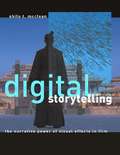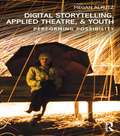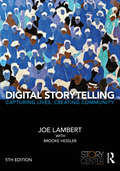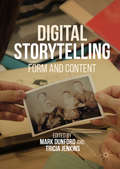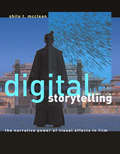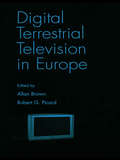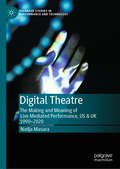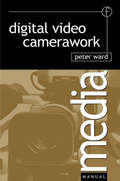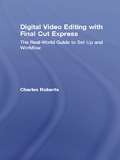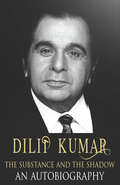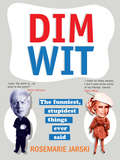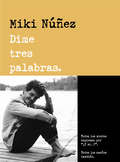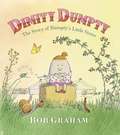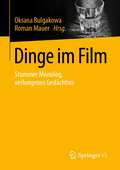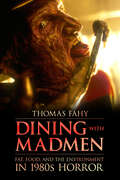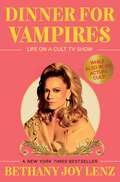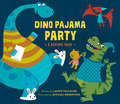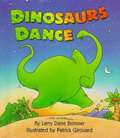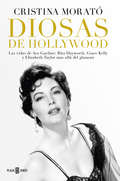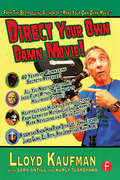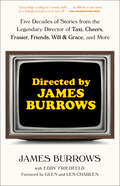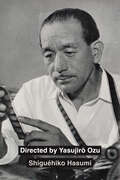- Table View
- List View
Digital Storytelling
by Shilo T. MccleanComputer-generated effects are often blamed for bad Hollywood movies. Yet when a critic complains that "technology swamps storytelling" (in a review of Van Helsing, calling it "an example of everything that is wrong with Hollywood computer-generated effects movies"), it says more about the weakness of the story than the strength of the technology. In Digital Storytelling, Shilo McClean shows how digital visual effects can be a tool of storytelling in film, adding narrative power as do sound, color, and "experimental" camera angles--other innovative film technologies that were once criticized for being distractions from the story. It is time, she says, to rethink the function of digital visual effects. Effects artists say--contrary to the critics--that effects always derive from story. Digital effects are a part of production, not post-production; they are becoming part of the story development process. Digital Storytelling is grounded in filmmaking, the scriptwriting process in particular. McClean considers crucial questions about digital visual effects-- whether they undermine classical storytelling structure, if they always call attention to themselves, whether their use is limited to certain genres--and looks at contemporary films (including a chapter-long analysis of Steven Spielberg's use of computer-generated effects) and contemporary film theory to find the answers. McClean argues that to consider digital visual effects as simply contributing the "wow" factor underestimates them. They are, she writes, the legitimate inheritors of film storycraft.
Digital Storytelling, Applied Theatre, & Youth: Performing Possibility
by Megan AlrutzDigital Storytelling, Applied Theatre, & Youth argues that theatre artists must re-imagine how and why they facilitate performance practices with young people. Rapid globalization and advances in media and technology continue to change the ways that people engage with and understand the world around them. Drawing on pedagogical, aesthetic, and theoretical threads of applied theatre and media practices, this book presents practitioners, scholars, and educators with innovative approaches to devising and performing digital stories. This book offers the first comprehensive examination of digital storytelling as an applied theatre practice. Alrutz explores how participatory and mediated performance practices can engage the wisdom and experience of youth; build knowledge about self, others and society; and invite dialogue and deliberation with audiences. In doing so, she theorizes digital storytelling as a site of possibility for critical and relational practices, feminist performance pedagogies, and alliance building with young people.
Digital Storytelling: Capturing Lives, Creating Community
by Joe Lambert Brooke HesslerIn this revised and updated edition of the StoryCenter's popular guide to digital storytelling, StoryCenter founder Joe Lambert offers budding storytellers the skills and tools they need to craft compelling digital stories. Using a "Seven Steps" approach, Lambert helps storytellers identify the fundamentals of dynamic digital storytelling – from conceiving a story, to seeing, assembling, and sharing it. Readers will also find new explorations of the global applications of digital storytelling in education and other fields, as well as additional information about copyright, ethics, and distribution. The book is filled with resources about past and present projects on the grassroots and institutional level, including new chapters specifically for students and a discussion of the latest tools and projects in mobile device-based media. This accessible guide’s meaningful examples and inviting tone makes this an essential for any student learning the steps toward digital storytelling.
Digital Storytelling: Form and Content
by Tricia Jenkins Mark DunfordThis edited collection brings together academics and practitioners to explore the uses of Digital Storytelling, which places the greatest possible emphasis on the voice of the storyteller. Case studies are used as a platform to investigate questions of concept, theory and practice, and to shine an interrogative light on this emergent form of participatory media. The collection examines the creative and academic roots of Digital Storytelling before drawing on a range of international examples to consider the way in which the practice has established itself and evolved in different settings across the world.
Digital Storytelling: The Narrative Power of Visual Effects in Film (The\mit Press Ser.)
by Shilo T. McCleanHow digital visual effects in film can be used to support storytelling: a guide for scriptwriters and students.Computer-generated effects are often blamed for bad Hollywood movies. Yet when a critic complains that "technology swamps storytelling" (in a review of Van Helsing, calling it "an example of everything that is wrong with Hollywood computer-generated effects movies"), it says more about the weakness of the story than the strength of the technology. In Digital Storytelling, Shilo McClean shows how digital visual effects can be a tool of storytelling in film, adding narrative power as do sound, color, and "experimental" camera angles—other innovative film technologies that were once criticized for being distractions from the story. It is time, she says, to rethink the function of digital visual effects.Effects artists say—contrary to the critics—that effects always derive from story. Digital effects are a part of production, not post-production; they are becoming part of the story development process. Digital Storytelling is grounded in filmmaking, the scriptwriting process in particular. McClean considers crucial questions about digital visual effects—whether they undermine classical storytelling structure, if they always call attention to themselves, whether their use is limited to certain genres—and looks at contemporary films (including a chapter-long analysis of Steven Spielberg's use of computer-generated effects) and contemporary film theory to find the answers. McClean argues that to consider digital visual effects as simply contributing the "wow" factor underestimates them. They are, she writes, the legitimate inheritors of film storycraft.
Digital Terrestrial Television in Europe
by Robert G. Picard Allan BrownDigital technology for the production, transmission, and reception of television is expected to replace analogue transmission throughout the world. The timetable for this transition is uncertain and different projections have been made for virtually every country in the world. This book gives the exhaustive details of the issues of this changeover in Europe and elsewhere. The details are placed within the context of the massive changes, which the television industry has been subjected to over the past 25 years.The rollout of digital terrestrial television (DTTV) in Europe is a significant issue for every country included in this survey. It is of such importance because DTTV is the centerpiece of many governments' policies toward making Europe the world leader in new information and communication technologies. These same governments are all wrestling with the issues of how to use the technology in ways that create both commercial and non-commercial value. European perspectives on the social, cultural, and political nature of broadcasting vary significantly from those in other parts of the world and require that the introduction of DTTV should be handled differently to its introduction elsewhere.There are enormous technical, political, and economic aspects to be considered and these vary from country to country in Europe. The two editors bring a perspective to this study as media economists who come to the European scene from other parts of the world. The book covers DTTV in depth, and it also includes discussions of cable, satellite, broadband, and Internet technology for comparison.
Digital Theatre: The Making and Meaning of Live Mediated Performance, US & UK 1990-2020 (Palgrave Studies in Performance and Technology)
by Nadja MasuraDigital Theatre is a rich and varied art form evolving between performing bodies gathered together in shared space and the ever-expanding flexible reach of the digital technology that shapes our world. This book explores live theatre performances which incorporate video projection, animation, motion capture and triggering, telematics and multisite performance, robotics, VR, and AR. Through examples from practitioners like George Coates, the Gertrude Stein Repertory Theatre, Troika Ranch, David Saltz, Mark Reaney, The Builder’s Association, and ArtGrid, a picture emerges of how and why digital technology can be used to effectively create theatre productions matching the storytelling and expressive needs of today’s artists and audiences. It also examines how theatre roles such as director, actor, playwright, costumes, and set are altered, and how ideas of body, place, and community are expanded.
Digital Transformation in The Recording Industry: Evolution of Power: From The Turntable To Blockchain (Routledge Research in the Creative and Cultural Industries)
by Anna Anetta JanowskaThe recording industry has famously been transformed by technology throughout its entire history.The book presents an analysis of these changes using Porter's five forces model. The author highlights the evolution of buyers' and suppliers' power, the emergence of new competitors, product innovation and rivalry between companies in the industry driven by economic, political, social and legal factors.As an early mover in the social diffusion of copyright-sensitive content, the recording industry reflected in this book serves as an important reference for the analysis of other cultural and creative sectors.
Digital Transformation in the Recording Industry: Evolution of Power: From The Turntable To Blockchain (Routledge Research in the Creative and Cultural Industries)
by Anna Anetta JanowskaThe recording industry has famously been transformed by technology throughout its entire history. The book presents an analysis of these changes using Porter's five forces model. The author highlights the evolution of buyers' and suppliers' power, the emergence of new competitors, product innovation and rivalry between companies in the industry driven by economic, political, social and legal factors. As an early mover in the social diffusion of copyright-sensitive content, the recording industry reflected in this book serves as an important reference for the analysis of other cultural and creative sectors.
Digital Video Camerawork (Media Manuals Ser.)
by Peter WardThis manual introduces digital camerawork techniques used in television and video production. Written as a practical guide, the author's step-by-step instructions take you through everything you need to know, from camera controls, to editing, lighting and sound. This text provides a solid foundation to build upon in the area of digital video production. In a period of transition between analogue and digital acquisition/recording formats Digital Video Camerawork provides up-to-date information familiarizing you with the different production styles and requirements. Diagrams are used to illustrate the technology and techniques explained.Digital Video Camerawork combines clear, technical explanations with practical advice. It is ideal for the less experienced broadcast camera operator and for students on media and television production courses.
Digital Video Editing with Final Cut Express: The Real-World Guide to Set Up and Workflow
by Charles RobertsSuitable for those new to nonlinear editing as well as experienced editors new to Final Cut Express, this book is an introduction to Apple's editing software package and the digital video format in general. You will come away with not only an in-depth knowledge of how to use Final Cut Express, but also a deeper understanding of the craft of editing and the underlying technical processes that will serve you well in future projects. Workflow, editing techniques, compositing, special effects, audio tools, and output are explained in clear, jargon-free terms. The book's emphasis is always on using Final Cut Express in the real world, and as such it is the only book to go beyond the interface to address crucial issues like proper setup, system configuration, hardware, the Mac operating system, what equipment to purchase, and troubleshooting common problems. Armed with this information, you will sidestep problems and complete projects of exceptional quality.
Dilip Kumar: The Substance and the Shadow
by Dilip KumarAn authentic, heartfelt and compelling narrative – straight from the horse’s mouth – that reveals for the first time numerous unknown aspects of the life and times of one of the greatest legends of all time who stands out as a symbol of secular India. Dilip Kumar (born as Yousuf Khan), who began as a diffident novice in Hindi cinema in the early 1940s, went on to attain the pinnacle of stardom within a short time. He came up with spellbinding performances in one hit film after another – in his almost six-decade-long career – on the basis of his innovative capability, determination, hard work and never-say-die attitude.In this unique volume, Dilip Kumar traces his journey right from his birth to the present. In the process, he candidly recounts his interactions and relationships with a wide variety of people not only from his family and the film fraternity but also from other walks of life, including politicians. While seeking to set the record straight, as he feels that a lot of what has been written about him so far is ‘full of distortions and misinformation’, he narrates, in graphic detail, how he got married to Saira Banu, which reads like a fairy tale!Dilip Kumar relates, matter-of-factly, the event that changed his life: his meeting with Devika Rani, the boss of Bombay Talkies, when she offered him an acting job. His first film was Jwar Bhata (1944). He details how he had to learn everything from scratch and how he had to develop his own distinct histrionics and style, which would set him apart from his contemporaries. After that, he soon soared to great heights with movies such as Jugnu, Shaheed, Mela, Andaz, Deedar, Daag and Devdas. In these movies he played the tragedian with such intensity that his psyche was adversely affected. He consulted a British psychiatrist, who advised him to switch over to comedy. The result was spectacular performances in laugh riots such as Azaad and Kohinoor, apart from a scintillating portrayal as a gritty tonga driver in Naya Daur. After a five-year break he started his ‘second innings’ with Kranti (1981), after which he appeared in a series of hits such as Vidhaata, Shakti, Mashaal, Karma, Saudagar and Qila.
Dim Wit: The Funniest, Stupidest Things Ever Said
by Rosemarie Jarski'They misunderestimated me' George W. Bush Einstein said only two things are infinite - the universe and human stupidity. So in deference to the dumbing down of our culture, comes Dim Wit - a collection of the most jaw-droppingly stupid things ever said. The cast includes every famous foot-in-mouther from George W Bush to Prince Philip, Paris Hilton to Jade Goody, not to mention hundreds of unsung idiots plucked from villages the world over. The result is a confederacy of dunces more pro-fun than profound - a clever witticism may coax an inward smile but it takes a really stupid remark to deliver a belly laugh. So pick up Dim Wit and prepare to embrace your inner moron - it may be the smartest thing you do...'My grandma overheard two women talking in a doctor's surgery. After a while, one said to the other, "Do you know, Mary, I don't feel too well. I think I'll go home."' - Robyn Jankel'I don't think anyone should write his autobiography until after he's dead.' - Samuel Goldwyn 'Winston Churchill? Wasn't he the first black President of America? There's a statue of him near me - that's black.' - Danielle Lloyd
Dime tres palabras
by Miki NuñezEmotivos y originales relatos escritos por Miki Núñez con un punto en común entre ellos: tres palabras aleatorias que hilan cada historia. «Esto quiere ser un libro feliz. Igual que yo. Puesto que esa es mi única meta en la vida. Así que dejaremos este pequeño prólogo de lado y os recomendaré algo. Cuando veas que alguien tiene miedo, míralo y dile: "Dime tres palabras". Y con esas tres palabras haz que se olvide de todo lo que ocurre a su alrededor, de los deberes, de los porqués, de los problemas... Que solo existan esas tres palabras y la historia que os inventéis alrededor de ellas. ¿Cómo lo sé? Porque lo he probado muchas veces y en este libro os lo voy a demostrar. Y sobre todo por ella. Por mi madre. Que me salvaba cada noche cuando entraba a mi habitación y me veía horrorizado y preocupado por todo. Se me acercaba y me susurraba: "¿Qué? ¿Me dices tres palabras...?".»
Dimity Dumpty: The Story of Humpty’s Little Sister
by Bob GrahamThe world needs more quiet heroes! With whimsy and warmth, Bob Graham tells the lesser-known tale of a shy little soul who saves the day. What happened to Humpty Dumpty is the stuff of legend. But how many know of his brave little sister? While the Tumbling Dumpties, the family traveling circus troupe, is doing acts of spectacular daring, Dimity stays far from the spotlight, playing tunes on her tiny flute. But when Humpty falls off the wall where he's writing graffiti, it's Dimity who finds her voice and brings help that even the king's soldiers can't provide. With a wealth of humorous visual details -- the egg-carton caravan drawn by a chicken, the bandaging of Humpty's "leakage" after his fall -- Bob Graham pays tribute to a famous nursery rhyme figure and brings smiles to his readers once again.
Dinge im Film: Stummer Monolog, verborgenes Gedächtnis
by Roman Mauer Oksana BulgakowaDas verborgene Gedächtnis des Kinos schlummert in den filmischen Dingen, die seine Bilder möblieren. Sie sind stets präsent, werden aber selten bewusst erfasst. Wer bislang den Blick auf diese Dinge richtete, verstand sie als materielle Kultur vergangener Zeiten, die der Film konserviert, manchmal auch als zu Objekten materialisierte Ideen. Die Beiträge dieses Bandes versuchen, die filmischen Dinge wie handelnde Personen zu betrachten und ihre stummen Monologe wahrzunehmen, um zu verfolgen, welche Interaktionen Dinge im Film auslösen, mit welchen Bedeutungen und emotionalen Färbungen sie in verschiedenen Genres und in Filmen aus diversen Epochen versehen wurden. Die Beiträge fragen, ob sich diese Bedeutungen der filmischen Dinge geändert haben und was diese Änderungen bestimmte. Wie wurde die Wahrnehmung eines filmischen Dinges, der Umgang mit ihm und seine affektive Ladung mit filmischen Mitteln inszeniert?
Dining with Madmen: Fat, Food, and the Environment in 1980s Horror
by Thomas FahyIn Dining with Madmen: Fat, Food, and the Environment in 1980s Horror, author Thomas Fahy explores America’s preoccupation with body weight, processed foods, and pollution through the lens of horror. Conspicuous consumption may have communicated success in the eighties, but only if it did not become visible on the body. American society had come to view fatness as a horrifying transformation—it exposed the potential harm of junk food, gave life to the promises of workout and diet culture, and represented the country’s worst consumer impulses, inviting questions about the personal and environmental consequences of excess.While changing into a vampire or a zombie often represented widespread fears about addiction and overeating, it also played into concerns about pollution. Ozone depletion, acid rain, and toxic waste already demonstrated the irrevocable harm being done to the planet. The horror genre—from A Nightmare on Elm Street to American Psycho—responded by presenting this damage as an urgent problem, and, through the sudden violence of killers, vampires, and zombies, it depicted the consequences of inaction as terrifying.Whether through Hannibal Lecter’s cannibalism, a vampire’s thirst for blood in The Queen of the Damned and The Lost Boys, or an overwhelming number of zombies in George Romero’s Day of the Dead, 1980s horror uses out-of-control hunger to capture deep-seated concerns about the physical and material consequences of unchecked consumption. Its presentation of American appetites resonated powerfully for audiences preoccupied with body size, food choices, and pollution. And its use of bodily change, alongside the bloodlust of killers and the desolate landscapes of apocalyptic fiction, demanded a recognition of the potentially horrifying impact of consumerism on nature, society, and the self.
Dinner for Vampires: Life on a Cult TV Show (While also in an Actual Cult!)
by Bethany Joy Lenz*NEW YORK TIMES BESTSELLER* A deliciously witty and inspiring memoir by One Tree Hill star Bethany Joy Lenz about her decade in a cult and her quest to break free. In the early 2000s, after years of hard work and determination to breakthrough as an actor, Bethany Joy Lenz was finally cast as one of the leads on the hit drama One Tree Hill. Her career was about to take off, but her personal life was slowly beginning to unravel. What none of the show’s millions of fans knew, hidden even from her costars, was her secret double life in a cult. An only child who often had to fend for herself and always wanted a place to belong, Lenz found the safe haven she’d been searching for in a Bible study group with other Hollywood creatives. However, the group soon morphed into something more sinister—a slowly woven web of manipulation, abuse, and fear under the guise of a church covenant called The Big House Family. Piece by piece, Lenz began to give away her autonomy, ultimately relocating to the Family’s Pacific Northwest compound, overseen by a domineering minister who would convince Lenz to marry one of his sons and steadily drained millions of her TV income without her knowledge. Family &“minders&” assigned to her on set, &“Maoist struggle session&”–inspired meetings in the basement of a filthy house, and regular counseling with &“Leadership&” were just part of the tactics used to keep her loyal. Only when she became a mother did Lenz find the courage to leave and spare her child from a similar fate. After nearly a decade (and with the unlikely help of a One Tree Hill superfan), she finally managed to escape the family’s grip and begin to heal from the deep trauma that forever altered her relationship with God and her understanding of faith. Written with powerful honesty and dark humor, Dinner for Vampires is an inspiring story about the importance of identity and understanding what you believe. <br><b>New York Times Bestseller</b></br>
Dino Pajama Party: A Bedtime Book
by Laurie WallmarkJoin the dinos for a bash before bedtime!Much like us, dinosaurs love to have fun. Dinosaurs from all around gather together to play instruments, dance, and sing before bedtime. But soon the dinosaurs grow tired and need their rest. This is a book that's sure to have kids following the dinos' lead as they get ready to go to sleep.
Dinosaurs Dance
by Larry Dane BrimnerThough other animals may twirl and prance, there is nothing like a dinosaur dance.
Diosas de Hollywood: Las vidas de Ava Gardner, Grace Kelly, Rita Hayworth y Elizabeth Taylor más allá del glamour
by Cristina MoratóLas actrices de la época dorada del cine toman el relevo a las Divas Rebeldes y Reinas Malditas de Cristina Morató. Las historias de estas cuatro grandes estrellas de cine nos trasladan a la época dorada de Hollywood. Tenían el mundo a sus pies, contaban con una legión de admiradores y protagonizaron sonados romances con los galanes más atractivos. Verdaderas diosas a los ojos del público, fueron las más deseadas y fotografiadas del mundo. La temperamental e indomable Ava Gardner, la deslumbrante sex symbol Rita Hayworth, la elegante y sensual Grace Kelly o la gran diva de los ojos violeta Elizabeth Taylor hicieron soñar a millones de espectadores. Más allá del lujo y el glamour, fueron mujeres de carne y hueso, vulnerables, tímidas e inseguras que solo deseaban ser amadas. Pero el amor les fue esquivo y sus vidas estuvieron marcadas por la soledad, los divorcios, las adicciones, los malostratos y los desengaños. Todas pagaron un elevado precio por llegar a lo más alto. Cristina Morató nos descubre el lado más humano de estas inolvidables estrellas del siglo XX, protagonistas de una vida mucho más intensa y dramática que la de cualquiera de los personajes que interpretaron en la gran pantalla. «En Hollywood, a las actrices nos trataban como si no tuviéramos alma».Ava Gardner
Direct Your Own Damn Movie! (Your Own Damn Film School {{series}} Ser.)
by Lloyd KaufmanFilm is a visual medium, the work of Eric Rohmer and Kevin Smith notwithstanding. It is important for a director and cinemtographer to use their VISUAL EYES in order to VISUALIZE how to make their movie most effective. Also, there is the messy business of actors. Generally, movies have them, and directors have to deal with them. This guide will illuminate these two main jobs of the director: directing the camera and directing the actor, while showing how these two jobs manifest themselves during practical filmmaking -- whether it be, 'Which shots can I lose and still tell my story since we're running out of time', or 'How do I get two actors who hate each other to perform a passionate sex scene',' all will be revealed.
Directed by James Burrows: Five Decades of Stories from the Legendary Director of Taxi, Cheers, Frasier, Friends, Will & Grace, and More
by James Burrows&“Being directed by the Jimmy Burrows, while on Friends, was like hitting the jackpot. I&’m delighted that everyone can now share in his incredible insight with this book.&”—JENNIFER ANISTONFrom the director of The Mary Tyler Moore Show, Taxi, Cheers, Frasier, Friends, and Will & Grace comes an insightful and nostalgic memoir that offers a bounty of behind-the-scenes moments from our favorite shows, peeling away the layers behind how a successful sitcom comes together—and stays that way.Legendary sitcom director James Burrows has spent five decades making America laugh. Here readers will find never-revealed stories behind the casting of the dozens of great sitcoms he directed, as well as details as to how these memorable shows were created, how they got on the air, and how the cast and crew continued to develop and grow. Burrows also examines his own challenges, career victories, and defeats, and provides advice for aspiring directors, writers, and actors. All this from the man who helped launch the careers of Ted Danson, Kelsey Grammer, Woody Harrelson, Jennifer Aniston, Debra Messing, and Melissa McCarthy, to name a few. Burrows talks fondly about the inspiration he found during his childhood and young adult years, including his father, legendary playwright and Broadway director Abe Burrows. From there he goes on to explain his rigorous work ethic, forged in his early years in theater, where he did everything from stage managing to building sets to, finally, directing. Transitioning to television, Burrows locked into a coveted job with The Mary Tyler Moore Show, where he first observed and then started to apply his craft. Directing most of the episodes of Taxi came next, where he worked closely with writers/producers Glen and Les Charles. The three formed a remarkable creative partnership that helped Burrows achieve his much sought-after goal of ownership and agency over a project, which came with the creating and directing of the seminal and beloved hit Cheers. Burrows has directed more than seventy-five pilots that have gone to series and over a thousand episodes, more than any other director in history.Directed by James Burrows is a heart-and-soul master class in sitcom, revealing what it truly takes to get a laugh.
Directed by Yasujiro Ozu
by Shiguéhiko HasumiFirst published in 1983, Shiguéhiko Hasumi's Directed by Yasujirō Ozu has become one of the most influential books on cinema written in Japanese. This pioneering translation brings Hasumi's landmark work to an English-speaking public for the first time, inviting a new readership to engage with this astutely observed, deeply moving meditation on the oeuvre of one of the giants of world cinema. Complemented by a critical introduction from acclaimed film scholar Aaron Gerow and rendered fluidly in Ryan Cook's agile translation, this volume will grace the shelves of cinephiles for many years to come.
Directing Actors: A Practical Aesthetics Approach
by Lee Michael CohnDirecting Actors: A Practical Aesthetics Approach is the first book to apply the Practical Aesthetics acting technique to the craft of directing. Lee Cohn lays out a step-by-step, no-nonsense methodology for the director that includes a deep dive into the mechanics of storytelling, the rehearsal process, working with writers, and the practical realities of the director’s job. Featuring end-of-chapter exercises, this book provides a clear and effective means of breaking down a script in order to tell a story with clarity, simplicity, and dramatic force and gives directors a clear working vocabulary that will allow effective communication with actors. The techniques in this book are applicable to any theatrical style and any media platform in which a director might work. Written in an accessible, conversational style, this book strips the process of directing down to its most essential components to explain how to become an "actor’s director." A must-read for students in directing courses and professional directors working with actors who prescribe to the Practical Aesthetics technique, as well as anyone interested in the process of working with actors, Directing Actors will help directors to get the very best their actors are capable of while approaching the work with a joyful, open spirit.
